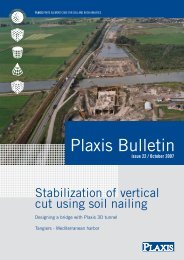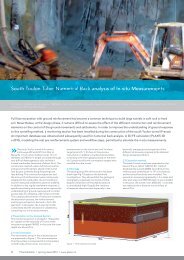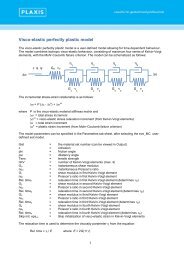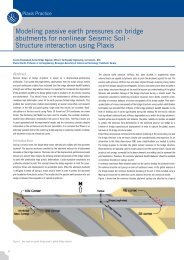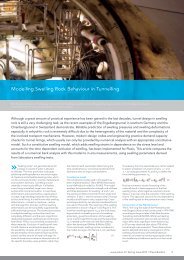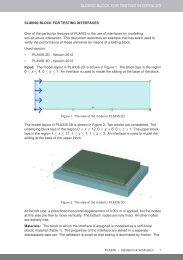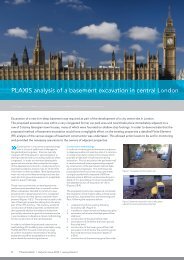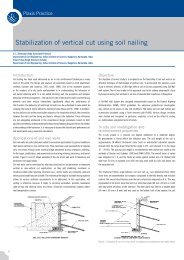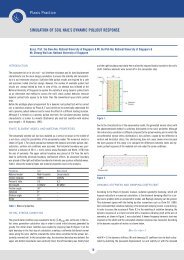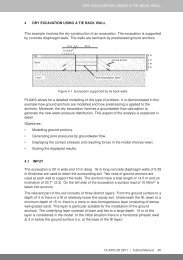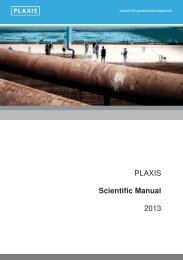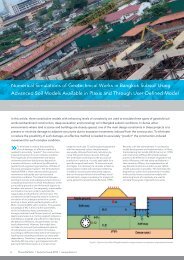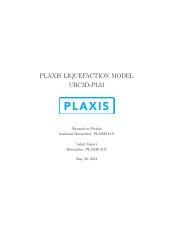Piled embankments in PLAXIS 2D, 3DTunnel and PLAXIS 3D 2011
Piled embankments in PLAXIS 2D, 3DTunnel and PLAXIS 3D 2011
Piled embankments in PLAXIS 2D, 3DTunnel and PLAXIS 3D 2011
Create successful ePaper yourself
Turn your PDF publications into a flip-book with our unique Google optimized e-Paper software.
For the situation with traffic load, it appears that<br />
the bend<strong>in</strong>g moments <strong>in</strong> the <strong><strong>3D</strong>Tunnel</strong> model<br />
are smaller than the two other predictions, <strong>and</strong><br />
probably not realistic. This difference is <strong>in</strong>itiated<br />
<strong>in</strong> the start of the phases with updated mesh.<br />
The updated mesh is required to properly model<br />
the membrane effect <strong>in</strong> the geogrid. Dur<strong>in</strong>g the<br />
excavation, the bottom of the excavation shows a<br />
heave. When the piles are activated, a pre-stress<br />
occurs. This is the ma<strong>in</strong> cause for the smaller<br />
bend<strong>in</strong>g moments. For the same reason, a large<br />
bend<strong>in</strong>g moment <strong>in</strong> the model of <strong>PLAXIS</strong> <strong>2D</strong> is<br />
present at -19m, but for this model correction is<br />
possible. S<strong>in</strong>ce the piles consist of one type of<br />
l<strong>in</strong>ear elements.<br />
Figures 1 <strong>and</strong> 2 show the tensile forces <strong>in</strong> the<br />
geogrids, <strong>in</strong> the directions perpendicular to the<br />
road. It should be noted that CUR226 predicts a<br />
maximum tensile force along the road of 96 kN/m,<br />
<strong>and</strong> across the road of 112 kN/m. This agrees very<br />
well with the <strong>3D</strong> predictions.<br />
The differences between the <strong>PLAXIS</strong> models do<br />
not <strong>in</strong>crease when the load is applied. The plots<br />
of the forces <strong>in</strong> the geogrids show that all <strong>PLAXIS</strong><br />
models, <strong>and</strong> especially <strong>PLAXIS</strong> <strong>2D</strong>, give peaks at<br />
the sides of the pile caps (these peaks decrease<br />
when the element sizes are reduced further), but<br />
generally, the maximum forces are similar to the<br />
<strong>PLAXIS</strong> <strong>3D</strong> model. The forces <strong>in</strong> the geogrids<br />
<strong>in</strong> the <strong>3D</strong> models are similar, but the <strong>PLAXIS</strong> <strong>3D</strong><br />
<strong>2011</strong> version gives higher values, especially <strong>in</strong> the<br />
direction parallel to the road.<br />
It can be concluded that <strong>PLAXIS</strong> <strong>3D</strong> <strong>2011</strong> is better<br />
suitable for modell<strong>in</strong>g piles than <strong><strong>3D</strong>Tunnel</strong> <strong>and</strong><br />
gives very promis<strong>in</strong>g results. The most important<br />
improvement <strong>in</strong> <strong>PLAXIS</strong> <strong>3D</strong> <strong>2011</strong> is the embedded<br />
pile, s<strong>in</strong>ce the bend<strong>in</strong>g moment <strong>and</strong> <strong>in</strong>itial stra<strong>in</strong> of<br />
the piles <strong>in</strong> the <strong>in</strong>stallation phase of the piles (with<br />
updated mesh) are less disturbed. The modell<strong>in</strong>g<br />
<strong>in</strong> <strong>PLAXIS</strong> <strong>3D</strong> <strong>2011</strong> is also easier <strong>and</strong> faster than the<br />
modell<strong>in</strong>g <strong>in</strong> <strong><strong>3D</strong>Tunnel</strong>.<br />
In the near future, the calculations results of the<br />
calculations will be compared to the measured<br />
data.<br />
References<br />
• CUR 226, 2010. Ontwerprichtlijn paalmatrassystemen<br />
(Design guidel<strong>in</strong>e piled <strong>embankments</strong>),<br />
ISBN 978-90-376-0518-1 (<strong>in</strong> Dutch).<br />
• EBGEO, 2010. Empfehlungen für den Entwurf<br />
und die Berechnung von Erdkörpern mit<br />
Bewehrungen aus Geokunststoffen – EBGEO,<br />
2. Auflage, German Geotechnical Society, ISBN<br />
978-3-433-02950-3 (<strong>in</strong> German). Also available<br />
<strong>in</strong> English: Recommendations for Design <strong>and</strong><br />
Analysis of Earth Structures us<strong>in</strong>g Geosynthetic<br />
Re<strong>in</strong>forcements – EBGEO, <strong>2011</strong>. ISBN<br />
978-3-433-02983-1 <strong>and</strong> digital <strong>in</strong> English ISBN<br />
978-3-433-60093-1).<br />
<strong>PLAXIS</strong> <strong>2D</strong> <strong><strong>3D</strong>Tunnel</strong> <strong>PLAXIS</strong> <strong>3D</strong><br />
Figure 1: Bend<strong>in</strong>g moment <strong>in</strong> pile, without traffic load<strong>in</strong>g<br />
Figure 2: Force <strong>in</strong> geogrid, with traffic load<strong>in</strong>g<br />
www.plaxis.nl l Spr<strong>in</strong>g issue 2012 l Plaxis Bullet<strong>in</strong> 11



